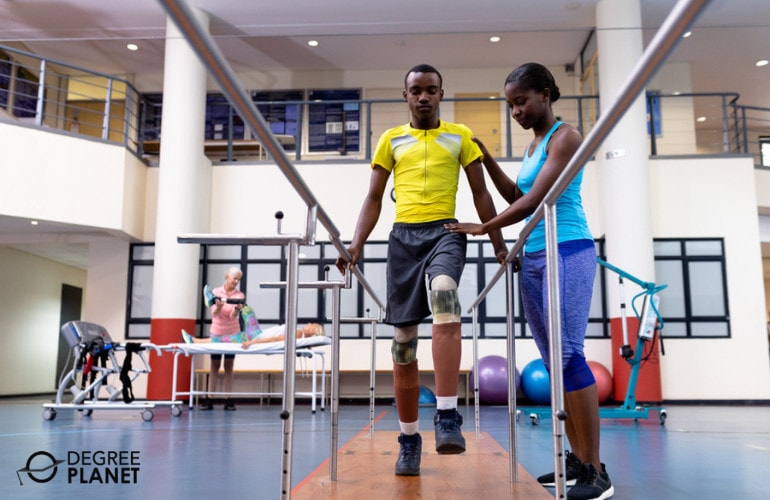Learning how to become a physical therapist can help set you on the path toward a rewarding, in-demand career in the healthcare sector.

Becoming a physical therapist can allow you to make a difference for others and their health and mobility needs.
Editorial Listing ShortCode:
A Doctor of Physical Therapy, also known as a DPT degree, is a requirement to become a physical therapist. We’ll take a look at what’s involved in this degree for physical therapy and how it can help you achieve your career goal.
How to Become a Physical Therapist
Becoming a physical therapist can take several years of dedicated study. Many students spend about 7 years getting the necessary training.
Editorial Listing ShortCode:
The process can vary somewhat from state to state, but the following outline provides a general overview of the steps you can expect as you work toward becoming a physical therapist:
- Go to college for a bachelor’s degree. An undergraduate degree will provide the foundation for your physical therapy training. You may be able to enroll in a pre-physical therapy bachelor’s degree program. Other fields of study to consider are exercise science, kinesiology, health science, or biomechanics.
- Gain experience. You can learn more about whether physical therapy is the right field for you by gaining experience in the field. This can also help you prepare for admission to a doctoral program. You may be able to obtain a paid aide or assistant position, or you could shadow a professional therapist as a volunteer. You may gain this experience during your undergraduate studies or afterward.
- Earn a doctoral degree. In a Doctor of Physical Therapy (DPT) program, you’ll gain classroom instruction and clinical practice that can prepare you to work as an independent physical therapist. It’s best to select a program that’s accredited by the Commission on Accreditation in Physical Therapy Education (CAPTE). That way, you can qualify to take the industry licensure test.
- Take the licensure exam. The National Physical Therapy Examination (NPTE) is a multiple-choice test that all prospective physical therapists must pass before they can apply for a license from their state.
- Meet other requirements. Your state may have additional requirements that have to be fulfilled before you can get a license. For example, you may be required to pass a background check.
- Apply for your license. Once you’ve met all the requirements, you can submit your application materials to your state board. With your license, you can work as a physical therapist.
- Join a residency program. If you’re interested in pursuing a specialty, you can complete a residency.
- Take a certification exam. After your residency, you can take the exam for your specialty. After you pass, you can qualify for board certification.
Continuing education throughout your career can help you maintain your license.
3 Things You Can Do as a Physical Therapist

The physical therapy field offers job opportunities with increasing levels of responsibility. As you further your education, you may also be able to advance through these three key roles.
1. Physical Therapist Aide
As you get started in the physical therapy field, working as an aide can give you firsthand experience.
Therapist aides usually learn their skills through on-the-job training. Aides work under the supervision of physical therapists and physical therapist assistants. They often do preparatory, cleaning, and clerical tasks.
2. Physical Therapy Assistant

For opportunities to work directly with patients, you might consider becoming a physical therapist assistant. As an assistant, you might help patients complete their stretches and exercises.
PT assistants can also talk to families about treatment plans and teach people how to use mobility equipment. Assistants need at least an accredited associate degree and state licensure.
In addition to traditional on-campus programs, a growing number of universities also offer physical therapy assistant programs online, which may help you to earn your educational credential while continuing to work.
3. Physical Therapist
Physical therapists are in charge of patients’ care plans. After reviewing medical records and evaluating patients, they can deliver the care themselves or can supervise assistants who help patients with their rehab activities.
Editorial Listing ShortCode:
Today’s physical therapists must hold a doctoral degree and be licensed.
Doctorate in Physical Therapy Specialty Areas

After earning your doctorate, you can choose to complete a residency and become board certified in a specialty area. Here are some common PT specialty areas:
- Geriatrics. Physical therapists who specialize in geriatric care understand the science of aging. They have the skills to support seniors with a variety of age-related health issues, including heart, lung, and musculoskeletal impairments.
- Oncology. Professionals who focus on oncology physical therapy provide services for cancer patients. They can work with patients who have a variety of other chronic illnesses as well.
- Pediatrics. Specialists in pediatrics serve babies through adolescents to help them achieve maximum mobility and the ability to engage in activities with their peers.
- Sports. Physical therapists who work in sports therapy help athletes prevent damage to the body, recover from injuries, and achieve their best possible performance.
- Cardiovascular and Pulmonary. Cardiovascular and pulmonary physical therapists provide services to help patients with heart or lung problems control symptoms and improve function.
In addition to these five official specialties, there are several others recognized by the American Board of Physical Therapy Specialties (ABPTS) as well.
Physical Therapy Careers & Salaries

According to the Bureau of Labor Statistics, the median salary for physical therapists is $91,010 per year.
| Careers | Annual Median Salaries |
| Physical Therapists — Nursing and Residential Care Facilities | $97,610 |
| Physical Therapists — Spectator Sports | $96,180 |
| Physical Therapists — Home Healthcare | $95,320 |
| Physical Therapists — Hospitals | $93,060 |
| Physical Therapists — Physical Therapy and Other Healthcare Offices | $85,680 |
| Physical Therapist Assistants | $59,770 |
| Exercise Physiologists | $50,280 |
| Athletic Trainers | $49,860 |
| Recreational Therapists | $47,710 |
| Physical Therapist Aides | $28,450 |
These salary figures represent national averages. Pay level can vary based on experience, board certification, geographic location, employer, and other factors.
How to Choose a Doctor of Physical Therapy Degree Program

For the best educational experience, it’s strategic to select a Doctor of Physical Therapy (DPT) program that provides strong academics and is a good fit for you. You can check on factors like those below to help you figure out where to go to school:
- Accreditation. For DPT programs, it’s beneficial to select a school with both regional and CAPTE accreditation so you can qualify to sit for the licensure exam after graduation.
- Clinical experiences. It’s typical to spend about 20% of your doctoral time in hands-on rotations supervised by an instructor. Learning more about where your clinical rotations would take place might help you decide where to attend.
- Online vs. on campus. Some colleges offer only in-person physical therapist schooling, but others have the option for you to take a portion of the courses online.
- Simulations. Some schools have virtual lab opportunities so that you can practice working with pretend patients before beginning real-life clinicals.
- Undergraduate arrangements. If you plan ahead, you may be able to enroll in a program that allows you to enter doctoral studies after only 3 years of undergraduate classes. Other schools offer bridge programs for physical therapist assistants to earn doctoral degrees.
You may also need to check with your state licensing board to make sure that your DPT program fulfills your local requirements.
Accreditation

Rigorous training is an essential part of becoming a licensed physical therapist, so it’s strategic to attend a school with a good reputation for educating students.
Regional accreditation is a type of certification that reputable schools can earn. It’s given out by authorized regional accrediting agencies. Regional accreditation is respected throughout higher education. Studying at an accredited school may help you transfer credits or get into a graduate program.
Editorial Listing ShortCode:
Down the road, an accredited degree could help you qualify for state licensure and secure a job as a physical therapist.
CAPTE Accreditation for Doctor of Physical Therapy Programs
In addition to regional accreditation, it’s beneficial to also look for programmatic accreditation from the Commission on Accreditation in Physical Therapy Education (CAPTE).
This organization verifies that doctoral programs meet industry standards for proper physical therapist preparation. CAPTE accreditation is essential. It can be a qualification to sit for the national licensure exam. Also, it can be a precondition to be able to receive Medicare reimbursement for services you provide to qualifying clients.
In addition to certifying doctoral programs for physical therapists in training, CAPTE also accredits physical therapist assistant programs at the associate degree level.
Is Financial Aid Available?

Yes, if you qualify, it’s possible to finance your physical therapy education with government and private financial assistance. To learn more about your options, you can submit the Free Application for Federal Student Aid (FAFSA).
Government student aid often comes from both state and federal sources. If you qualify, you may be able to secure loans for both your undergraduate and graduate studies. Grants, which are free tuition money, are more common for bachelors students than doctoral students.
Scholarships and fellowships may be available at any point in your college career. These awards can come directly from your school, an industry organization, your employer, or a private source.
What Do Physical Therapists Do?

Physical therapists are healthcare professionals who help patients improve their mobility and decrease their pain levels. They understand anatomy, physiology, and movement, and they are trained to create and implement treatment plans to address patients’ health issues.
Physical therapists use mobility devices, exercises, stretches, massages, and other techniques to help their patients. They can partner with assistants and aides to deliver these treatments and support their patients’ needs.
Although others in a practice may deliver some of the hands-on care, physical therapists are the ones responsible for crafting treatment plans and monitoring progress.
How Much Do Physical Therapists Make?

According to the Bureau of Labor Statistics, most physical therapists earn between $63,530 and $126,780 each year. Nursing homes and other residential care facilities pay some of the top salaries in this industry. The median annual salary for these industries is $97,610.
Those who enter this field as physical therapy assistants may earn between $33,840 and $82,470 annually. The highest wages may be found in skilled nursing facilities and home healthcare organizations.
Editorial Listing ShortCode:
Exercise physiologists make a median of $50,280 per year, and athletic trainers bring in a median annual salary of $49,860 (Bureau of Labor Statistics).
Where Do Physical Therapists Work?
According to the Bureau of Labor Statistics, over 30% of physical therapists work in office settings. This can include standalone physical therapy offices and facilities with a variety of healthcare providers, such as occupational and speech therapists and audiologists.
Around one-quarter of physical therapists work in hospitals. This includes private, state, and local hospitals. Other common work locations include nursing homes, residential facilities, and home healthcare agencies. Some physical therapists are self-employed.
What Degree Do You Need to Be a Physical Therapist?

According to current industry requirements, it’s necessary to earn a Doctor of Physical Therapy (DPT) if you want to become a physical therapist.
A bachelors degree alone isn’t enough, and most accredited schools have phased out physical therapy masters degree programs in favor of doctoral training.
Some previously qualified physical therapists may hold only a master’s degree. The American Physical Therapy Association (APTA) encourages such professionals to continue their education and earn a doctorate. Rules about whether this is a requirement for remaining licensed may vary from state to state.
How Long Does It Take to Become a Physical Therapist?

Becoming a physical therapist usually requires earning a bachelor’s degree and then a doctorate. In general, bachelor’s degree programs take 4 years, and Doctor of Physical Therapy programs typically take another 3 years.
Clinical experiences will account for a good portion of doctoral studies. A program may include an internship that lasts around 6 months. Some colleges offer fast-track programs that allow students to spend only 3 years on undergrad studies before moving into a doctoral program.
How long it takes to qualify for licensure after completing a doctorate can vary based on your state’s rules.
What Are the Skills Required to Be a Physical Therapist?

Here are some skills that are necessary for a physical therapist to possess:
- Good communication skills. Physical therapists have to explain diagnoses to patients and their families and provide information about treatment options. Also, they need to communicate how to perform stretches or use mobility equipment.
- Observation skills. PTs have to keep an eye on how their patients move and the ways that they respond to treatment. Keeping detailed records of these observations can allow them to adjust treatments as needed.
In addition, a physical therapist’s own strength and mobility can also help them support patients, demonstrate exercises, and perform therapeutic massages.
Are Physical Therapists Doctors?
Currently, becoming newly licensed as a physical therapist requires holding a doctorate. That means that most physical therapists, especially those newer to the field, are doctors. They’re not doctors who practice medicine, though.
Editorial Listing ShortCode:
The correct term is Doctor of Physical Therapy (DPT). That’s different from being a medical doctor (MD). Even still, physical therapists can use the title “doctor.”
What’s the Difference Between an Occupational Therapist vs. Physical Therapist?
For those who want a career dedicated to providing therapeutic services, either occupational therapy or physical therapy could be an option.
| Occupational Therapy | Physical Therapy |
|
|
While there are some similarities between these two professions, they have two distinct educational paths. So, it’s often necessary to decide which path is best for you before enrolling in grad school.
Is Physical Therapy a Good Career?

Yes, physical therapy is a good career field for many professionals. Choosing this profession can offer countless opportunities to play a key role in people’s health and wellbeing. You may have the chance to make a real difference for others.
Also, physical therapists are in demand. The Bureau of Labor Statistics predicts that the next 10 years will bring 18% job growth for this occupation. The rising age of the population will be an important factor in the increased demand for PT professionals.
Getting Your Doctorate in Physical Therapy Online

A physical therapy career can be a fulfilling way to help others and contribute to their quality of life.
Becoming a licensed physical therapist requires earning a Doctor of Physical Therapy (DPT) degree. Through your education and clinical experiences, you can gain the necessary skills for treating patients.
Getting a doctorate takes time. If you have a busy schedule, you may wonder how you can make that work. Online DPT programs could be the solution. You may be able to enroll in online courses and complete your in-person clinicals at convenient times.
It’s never too soon to explore how an accredited online program could lead to your DPT degree!

